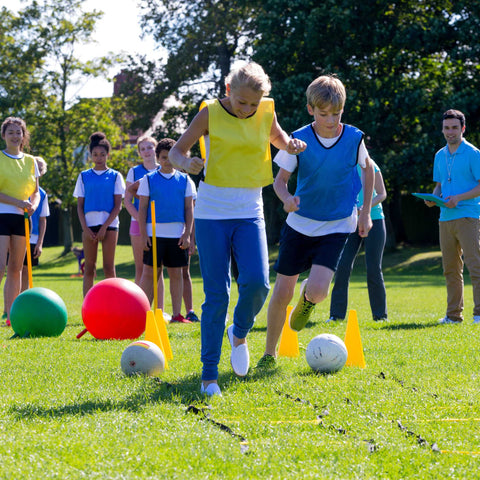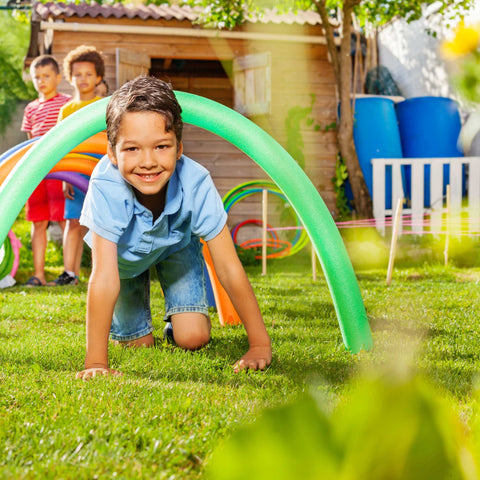
Weekend Activity: DIY Backyard Obstacle Course
Contents
Last 10 Articles
- This Is Why Unstructured Playtime Is Vital for Your Child’s Development
- Dog Food Hacks for Picky Eaters: Healthy Tips to Ensure They Love Mealtime
- When to Seek Medical Attention: Recognizing the Signs in Sick Kids*
- Kid-Friendly Veggie Smoothies: Delicious Recipes Even Picky Eaters Can’t Resist
- Sleeping Through the Night: Expert Tips That Will Make Parents and Kids Happier
- How Veggie Powders Fill Nutritional Gaps: The Essential Guide for Parents
- Navigating the New Challenges of Parenting Elderly Parents with Compassion
- Quick & Healthy Breakfast Ideas That Will Make Your Mornings Easier
- Why You Should Adopt These Tantrum Taming Techniques
- Turning Spring Cleaning into a Game: Engaging Kids in Household Chores
In today's technology-driven world, it's crucial to find ways to encourage physical activity, not just for children but also for adults. Regular exercise promotes better physical and mental health, reduces the risk of chronic diseases, and improves overall well-being.
By introducing fun and engaging activities like obstacle courses, families can make exercise a regular part of their routine while bonding and having fun together.
The goal of this blog is to inspire readers to transform their backyard into an exciting playground by creating a DIY obstacle course. By providing step-by-step instructions and creative ideas, the blog aims to empower readers to design and set up their own obstacle course tailored to their space, resources, and preferences.
Whether it's for a weekend family activity or a regular outdoor adventure, a backyard obstacle course offers endless opportunities for fun and fitness.
Benefits of DIY Backyard Obstacle Courses
Physical Exercise and Cardiovascular Health
DIY backyard obstacle courses provide an excellent opportunity for physical exercise, promoting cardiovascular health and improving endurance. Participants navigate hurdles, balance beams, and climbing walls, enhancing overall fitness and motivation, making it an enjoyable alternative to traditional exercise methods.
Development of Motor Skills and Coordination
Engaging in physical development activities like DIY backyard obstacle courses enhances children's physical abilities, such as balance, agility, and spatial awareness, by strengthening muscles, improving coordination, and preparing them for various sports and activities.
Opportunities for Creativity and Problem-Solving
Participants in a DIY backyard obstacle course engage in creative problem-solving through obstacle designs. The course encourages critical thinking, creativity, and resilience, while fostering teamwork and cooperation through collaboration with family members or friends.
Planning Your Obstacle Course
Assessing Available Space and Resources
Before designing your DIY backyard obstacle course, take stock of the available space and resources. Consider the size and layout of your backyard, including any existing structures or landscaping features that could be incorporated into the course.
Ensure there is enough room to maneuver between obstacles and that the course is safe and accessible for participants of all ages. Additionally, assess the materials and equipment you have on hand, such as ropes, cones, tires, and plywood, which can be repurposed to create obstacles.
Setting Goals and Objectives for the Obstacle Course
The objectives of a DIY backyard obstacle course should align with desired outcomes, promoting physical activity, skill development, and enjoyment. Considering participants' fitness levels and abilities, the course's design will guide the layout and achieve these goals.
Choosing Appropriate Obstacles and Challenges
The course involves a variety of obstacles and challenges designed to engage participants in a fun and engaging activity. The obstacles target different muscle groups and skills, such as balance, strength, agility, and coordination. The course is designed to be age-appropriate and scalable, ensuring participants stay motivated and engaged throughout.
Designing Obstacles and Challenges

Incorporating Elements for Agility and Balance
When designing your DIY backyard obstacle course, consider incorporating elements that challenge agility and balance. Balance beams made from wooden planks or logs can provide a test of stability, while stepping stones or tires laid out in a zigzag pattern require participants to navigate carefully to maintain balance.
Additionally, consider adding agility drills such as cone drills or ladder runs to improve footwork and coordination. These obstacles not only enhance physical skills but also encourage focus and concentration as participants navigate through the course.
Introducing Activities for Strength and Endurance
To target strength and endurance, include activities that require participants to exert physical effort and sustain activity over time. Rope climbs, monkey bars, and hanging rings provide opportunities to build upper body strength and grip endurance.
Incorporate challenges like push-ups, squats, or burpees at various stations throughout the course to engage different muscle groups and elevate heart rate. By including strength-building exercises, you can promote overall fitness and resilience while adding variety to the obstacle course experience.
Adding Fun and Creative Components to Keep Participants Engaged
DIY backyard obstacle courses can be enhanced by incorporating fun and creative components, sparking imagination and excitement among participants. These elements, including themed obstacles and interactive elements, create a memorable and enjoyable experience for all ages.
Gathering Materials and Equipment
Utilizing Household Items and Recycled Materials
DIY backyard obstacle courses can be created using household items and recycled materials. Old tires, wooden pallets, ropes, and hula hoops can be used to create hurdles, balance beams, and platforms. This sustainable approach reduces costs and promotes sustainability.
Purchasing or Borrowing Equipment as Needed
To enhance your obstacle course, consider borrowing gymnastics mats, agility cones, rope ladders, or other items. These versatile items can be added to your course, providing a well-rounded and dynamic experience. Reach out to friends, neighbors, or local organizations for temporary borrowing.
Ensuring Safety by Selecting Suitable Materials and Checking for Potential Hazards
When creating a DIY backyard obstacle course, safety should be a top priority.
Gather sturdy, durable materials free from potential hazards. Inspect all items for wear and tear, discarding any that pose a risk. Securely anchor obstacles to the ground and consider placing safety mats or padding beneath high-impact areas. This proactive safety measure ensures a fun and safe environment for participants.
Setting Up the Obstacle Course
Arranging Obstacles in a Logical and Challenging Sequence
The course involves arranging obstacles in a logical sequence to engage participants. By mapping out the layout and identifying key areas for different challenges, participants can target different muscle groups and skills. A cohesive course layout maximizes efficiency and keeps participants engaged, ensuring they move fluidly from one challenge to the next.
Catering Clear Pathways and Markers for Navigation

The course design should incorporate clear pathways and markers to guide participants through the obstacles. Utilizing cones, flags, chalk markings, signage, and visual cues like colored tape or banners can enhance visibility and make the course more engaging. This ensures smooth navigation and confidence for participants, ensuring a smooth and enjoyable experience.
Consider Age and Skill Level of Participants
When designing your obstacle course layout, it's essential to consider the age and skill level of the participants. Tailor the complexity and intensity of obstacles to suit the abilities of your intended audience, whether children, teenagers, or adults. For younger participants, focus on simple challenges that promote coordination and confidence-building, such as crawling tunnels or low-hanging monkey bars.
For older participants or those with more advanced skills, incorporate obstacles that offer greater physical and mental challenges, such as rope climbs or balance beams. By adapting the course layout to accommodate different age groups and skill levels, you can ensure that everyone has a positive and rewarding experience.
Safety Guidelines and Precautions
Inspecting Equipment and Obstacles for Stability and Integrity
Before participants begin navigating the obstacle course, it's crucial to inspect all equipment and obstacles for stability and integrity. Check for any signs of wear and tear, such as loose bolts, frayed ropes, or broken components, and repair or replace them as needed.
Ensure that all structures are securely anchored to the ground and can support the weight of participants without tipping over or collapsing. By conducting thorough inspections and maintenance checks, you can mitigate the risk of accidents or injuries during the course.
Providing Proper Supervision and Guidance for Participants
The course requires proper supervision and guidance to ensure the safety of participants. Delegated supervisors or volunteers monitor different sections, intervening if safety concerns arise. Educate participants on navigation techniques and encourage them to seek assistance if needed. This proactive approach prevents accidents and fosters a supportive environment.
Establishing Rules and Boundaries to Prevent Accidents or Injuries
Establishing clear rules and boundaries is essential for preventing accidents or injuries during the obstacle course activity. Communicate safety guidelines to all participants before they begin the course, emphasizing the importance of following instructions and respecting boundaries. Enforce rules such as no running or pushing, staying on designated pathways, and refraining from reckless behavior. Set clear boundaries for areas that are off-limits or pose potential hazards, such as steep inclines or bodies of water. By establishing firm rules and boundaries, you can create a safe and secure environment where participants can enjoy the obstacle course with confidence and peace of mind.
Hosting and Enjoying the Obstacle Course

Inviting Friends, Family, or Neighbors to Join in the Fun
Make your DIY backyard obstacle course a social event by inviting friends, family, or neighbors to join in the fun. Send out invitations or create a group chat to spread the word about the upcoming activity and encourage participation.
Consider hosting a themed obstacle course party to add an extra element of excitement, such as a pirate treasure hunt or superhero challenge. By inviting others to join, you can create memorable experiences and strengthen bonds through shared laughter and adventure.
Encouraging Friendly Competition and Teamwork
Divide participants into teams or pairs to encourage teamwork and collaboration in an obstacle course. Encourage sportsmanship by awarding prizes or certificates to participants who demonstrate exceptional teamwork, perseverance, or creativity.
Capturing Memories with Photos or Videos of the Obstacle Course in Action
The backyard obstacle course is a thrilling way to engage in backyard adventures, showcasing the camaraderie and excitement of the participants. Capture the highlights of the event, share it on social media, and inspire others to embark on similar adventures.
Clean Up and Maintenance
Removing Obstacles and Equipment to Prevent Accidents
After the obstacle course fun has come to an end, it's essential to promptly remove obstacles and equipment to prevent accidents or injuries. Clear the course of any debris, obstacles, or equipment that may pose tripping hazards or impede movement.
Encourage participants to help with cleanup efforts by returning borrowed equipment to its designated storage area and picking up any items left behind. By promptly removing obstacles and equipment, you can ensure a safe and hazard-free environment for future activities in your backyard.
Storing Materials Properly for Future Use
Properly storing materials and equipment is key to preserving their condition and longevity for future use. Invest in storage solutions such as bins, shelves, or cabinets to organize and protect your obstacle course materials from damage, moisture, or pests. Label storage containers to easily identify and access items when needed, and designate a dedicated storage area in your garage, shed, or basement for obstacle course supplies. Regularly inspect stored materials for signs of wear or damage and replace or repair as necessary to maintain their quality and functionality over time.
Performing Routine Maintenance and Repairs as Needed
Regular maintenance is crucial for a DIY backyard obstacle course to ensure its safety and functionality. Regular inspections and repairs are necessary to assess the course's condition, preventing wear and damage, and extending its lifespan.
Summary
DIY backyard obstacle courses offer a multitude of benefits for both children and adults, promoting physical activity, creativity, and teamwork. These engaging setups provide an opportunity for individuals of all ages to develop essential motor skills, coordination, and problem-solving abilities while having a blast in the comfort of their own backyard.
By incorporating a variety of obstacles and challenges, you can tailor the course to suit different age groups and skill levels, ensuring that everyone can participate and enjoy the experience.
Reminders of Safety Precautions and Considerations
While DIY backyard obstacle courses are a fantastic way to stay active and have fun, safety should always be a top priority. Before setting up your course, take the time to carefully inspect equipment and obstacles for stability and integrity, and ensure proper supervision and guidance for participants, especially young children.
Establish clear rules and boundaries to prevent accidents or injuries, and encourage participants to adhere to safety guidelines throughout the course. By prioritizing safety precautions and considerations, you can create a safe and enjoyable environment for everyone to enjoy.
Get Creative and Have Fun

Incorporating a DIY backyard obstacle course into your weekend activities is a fantastic way to promote physical fitness, creativity, and family bonding. Get creative with obstacle designs and challenges, and encourage participants to think outside the box and unleash their imagination. Whether you're hosting a backyard obstacle course for family fun, neighborhood gatherings, or birthday parties, the possibilities are endless. So, grab your supplies, gather your friends and family, and embark on an exciting adventure filled with laughter, teamwork, and unforgettable memories right in your own backyard!
Leave your comments below; we love to hear from you! And don't forget to follow Easy Peasie for more veggie info and convo on YouTube, Facebook, and Instagram! ~ThePeas





